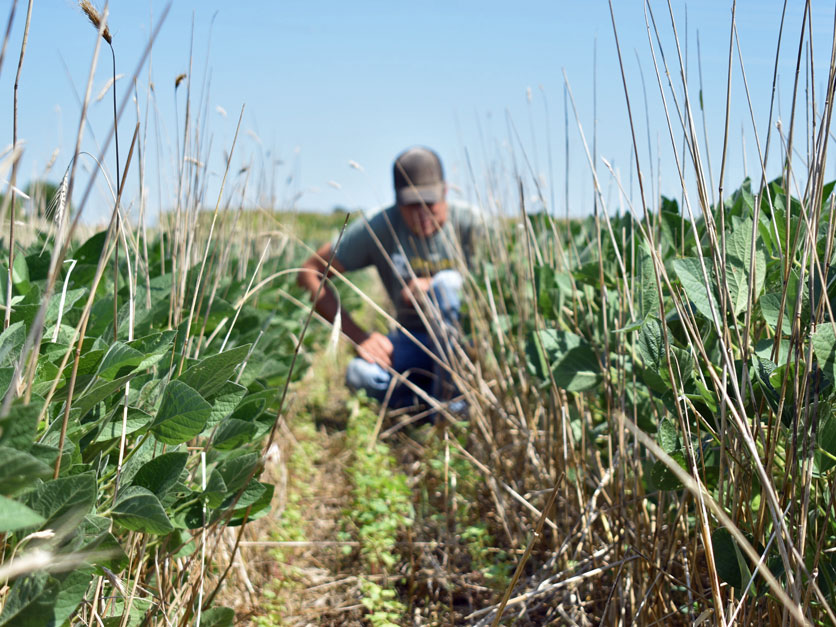The Food and Agriculture Climate Alliance proposed a series of new farm bill provisions Wednesday that the coalition of ag, food and conservation groups believes are needed to help producers and landowners address climate change.
The proposals include expanding conservation technical assistance; requiring an update of conservation practice standards to address their “effectiveness on climate mitigation and resilience;” streamlining assistance for cover crops and other conservation practices.
During a press conference held on Capitol Hill Wednesday afternoon, Randy Russell of the Russell Group says the 109 recommendations do not have a final cost estimate as it will depend on how Congress drafts the recommendations. He says a lot of the recommendations do not require new legislation. Instead, some require working with the administration and regulatory agencies to streamline things such as feed approval processes, ag biotech innovation and other actions that help advance climate-friendly activities.
In a 30-page report, the coalition also wades into the issue of farm program payment limits, saying that “given the urgency of climate change,” USDA should have the authority to waive income limits in some programs.
USDA also needs to review the federal crop insurance program to find any “potential policies or modifications … that constrain the adoption of climate smart farming practices,” FACA says.
FACA has proved influential in getting the Biden administration and the last Congress to address its proposals for increased conservation funding and a series of pilot projects that will test potential markets for climate-smart commodities.
FACA’s founding members include the American Farm Bureau Federation, National Farmers Union, National Council of Farmer Cooperatives, Environmental Defense Fund, The Nature Conservancy and FMI-The Food Industry Association. Dozens of other agribusiness and environmental groups also participate.
The farm bill recommendations mirror the priorities outlined in FACA’s previous proposals, including a broad emphasis on using USDA conservation programs to encourage farmers to adopt practices that reduce greenhouse gas emissions and can make operations more resilient to droughts, floods and other weather-related disasters.
NFU President Rob Larew said the recommendations also recognize and reward the work of early adopters of climate smart practices.
“Further reducing emissions throughout the agricultural and forestry supply chain will require a comprehensive effort involving financial and technical assistance, research investments, proactive response to innovation, public-private partnerships, and a commitment to equitable opportunities for all producers,” the alliance says in its latest report.
The new recommendations call for Congress to protect the nearly $20 billion increase in conservation funding provided to USDA through the Inflation Reduction Act. The money includes $18 billion for four conservation programs.
Elizabeth Gore, senior vice president for political affairs at Environmental Defense Fund, said FACA recognizes that conservation programs have been underfunded and oversubscribed for a long time.
"It's completely voluntary, and it's a place where farmers want to do more. And we want to provide the resources to make sure that they can do more," she said in why FACA supports a continuation of higher conservation funding in the farm bill.
Going forward, the alliance wants Congress to ensure USDA’s Natural Resources Conservation Service is more proactive in revising conservation standards to reflect “new practices and technologies in a timely manner. Currently, producers and stakeholders must petition NRCS through the local, state, and then national level to gain interim status for new practices and technologies,” FACA says.
The alliance also calls for earmarking 1% of conservation program funding for a new conservation technical assistance initiative that would be targeted toward increasing climate resilience and reducing greenhouse gas emissions.
"The funds should be used to recruit and train additional technical service providers (TSPs) and staff to provide on-the-ground support. Streamline the TSP certification process, including for certified crop advisors, and cooperative-based agricultural staff and scientists," the report says.
Don’t miss a beat! It’s easy to sign up for a FREE month of Agri-Pulse news! For the latest on what’s happening in Washington, D.C. and around the country in agriculture, just click here.
Chuck Conner, president and CEO of the National Council of Farmer Cooperatives, highlighted recommendations in livestock and food waste. He says the livestock sector often gets blamed for ag emissions but has a "great story to tell on innovation, sustainability and positive climate contributions." He adds the recommendations focus on three areas: manure management, feed and nutrition and pasture and grazing practices.
As it relates to food waste, Conner says the recommendations suggest establishing the position of a food waste liaison permanent with shared responsibilities between USDA, Food and Drug Administration and the Environmental Protection Agency.
Among other recommendations:
- Reduce partnership contribution amounts and facilitate participation by farmer cooperatives in the Regional Conservation Partnership Program.
- Add practices in the Environmental Quality Incentives Program and Conservation Stewardship Program to expand the use of legumes, forbs, and pollinators in grazing.
- Fund measuring and monitoring of soil carbon sequestration on land enrolled in the Conservation Reserve Program.
- Provide “streamlined delivery of incentives for cover crops and other climate-related practices." The incentives should be “based on annual crop reporting, a short checklist of practice requirements, and include practices that require limited technical assistance and conservation planning resources.”
- Incentivize the purchase of "new, cutting-edge" precision ag equipment that "is often prohibitively expensive."
- Encourage the inclusion of specialty crops in conservation programs.
- Raise limits on some Farm Service Agency loan programs. The limit on microloans should be increased from $50,000 to $100,000, while the limit on direct farm operating loans should rise to $600,000 from $400,000, FACA says.
- Recruit and train new NRCS staff as well as additional technical service providers to assist producers in installing anaerobic digesters and manure management technologies.
- Remove barriers to the adoption of manure management systems and expand aid for non-biogas manure management systems.
- Ensure NRCS adequately incorporates feed and nutrition management as a tool to reduce emissions. “Currently there is no conservation planning assistance for livestock producers who are working to reduce emissions from their animals,” FACA says.
For more news, go to Agri-Pulse.com.



